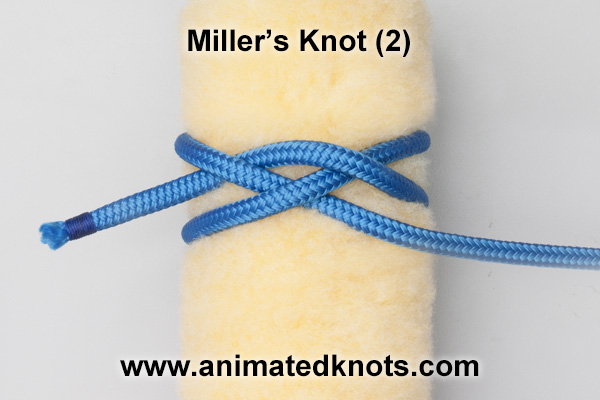Secures neck of a sack or bundle of items.
Miller’s Knot
Secures neck of a sack or bundle of items.
 |  |

 |  |  |  |  |
To Step use Arrow Keys (
Uses: The Miller Knots (ABOK #1241 and 1242 , p 224.) are members of a family of binding loops. They are used to secure the neck of a sack or to bind a roll or a bundle. There are many similar “Miller’s” knots and Ashley’s own notes provide a very useful summary:
1241. The Miller’s Knot (1) is a fairly good Binding Knot that is often given in farm bulletins. Any of the Miller’s Knots may employ a bight or loop for the final tuck instead of an end. This makes slipknots of them and saves the bag from being injured when the cord is being cut.
1242. Miller’s Knot (2). This is the first move for a Three Lead, Two-Bight Turk’s Head. It is a fairly good knot for a bag, being simple to tie, but it sometimes capsizes.
1243. The Sack Knot is of the same formation as the Fisherman’s Ground Line Hitch, and also the Artilleryman’s Picker-Line Hitch. Moreover it is the start of the Three Lead, Four-Bight Turk’s Head. Added to these uses, it serves very well around the
neck of a sack.
1244. The Bag Knot constricts better than most of the knots so far given and makes a very practical Miller’s Knot.
1245. The Clove Hitch, although an excellent Crossing Knot, is not a good binder, although often used for the purpose.
1239. The Strangle Knot starts with a round turn and the end is stuck under two parts. It may be used to tie up a roll. If required, a loop may be stuck instead of the end, which makes a slipped knot that is one of the best for tying up sacks and meal bags.
1249. The Constrictor Knot. At the time when the sinnets of Chapter 39 were being made there was no knot that would hold secure the large number of strands that were required for some of them. For a while seizings were employed, which served the purpose well but took too much time to tie. Then the knot shown here was evolved, which proved in every way adequate. So long as the Constrictor is tied over a convex surface it will not slip. It draws up easily, has a ratchetlike grip and is the most secure of all Binding
Knots.
In the twenty-five years and more that have elapsed since I first tied the knot, I have shown it to many people, and a number of fishermen sailing out of New Bedford now use it for whippings and stoppings. It is also used for the same purpose in several chandleries.
I have found it convenient for tying any kind of a roll, for hanging Christmas stockings to a crane, and for seizing garden hose and atomizer bulbs.
Conclusion: As usual, it’s hard to improve on Ashley’s words.












